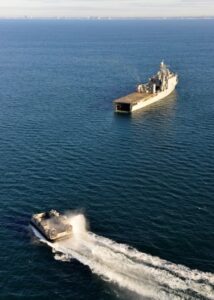A Marine Corps official told a congressional panel Wednesday the Navy’s plans to reduce amphibious warships in the medium term from 24 ships will add risk to the service’s ability to respond to crises, particularly outside the Indo-Pacific region.
During a House Armed Services seapower subcommittee hearing on May 18, Rep. Elaine Luria (D-Va.) asked a top Marine Corps official what the risk is in the Navy’s plan to reduce the amphibious warship force to 24 ships by FY ‘24, well under the Marine Corps’ requirement of 31 ships.
“The Marine Corps’ concern is that as the coming years when we go down to 24, it is my assessment that at 24, we will likely be able to provide adequate capability in the Indo-Pacific and we will be forced to take risk in EUCOM, AFRICOM and CENTCOM, there’s no two ways around it,” Lt. Gen. Karsten Heckl, Deputy Commandant of the Marine Corps for Combat Development and Integration, said.
Heckl said he used the word ‘likely’ for the Indo-Pacific capabilities because “based on readiness rates of ships, I’m always cautious, I will approach from the worst case scenario vice the best case.”
Several Marine Corps officials, including Heckl during the hearing, have said the service’s “absolute requirement” for amphibious ships is 31 vessels: 10 LHA/LPD larger deck amphibious assault ships and 21 San Antonio-class LPD-type amphibious transport docks.

However, according to the Navy’s FY 2023 budget request and long-term shipbuilding plan, the department will stop building San Antonio-class Flight II LPD ships after LPD-32 and the Navy plans to retire 10 older Whidbey Island/Harpers Ferry (LSD-41/49) classes between three and 14 years earlier than planned. The LPD Flight II was planned to replace the LSDs.
The Navy also pushed back procurement of the first of up to 35 new class Light Amphibious Warships (LAW) to FY ‘25.
If approved by Congress, according to the Navy’s latest long term shipbuilding plan, these decisions will result in the amphibious warship force falling to 24 vessels by FY ‘24 and not returning to 31 ships or more until 2030-31, depending on which of three alternatives in the shipbuilding plan is used.
Heckl elaborated since the Marine Corps is tasked with being the country’s crisis response force the risk in reducing amphibious ships means “that we will not be able to have adequate forces forward to respond in a timely manner.”
“The implication of crisis response is timely response. So, again, I’ll come back to the whole thing, the discussion about time can often represent risk that can’t be overcome. So that’s, I think, the biggest issue, ma’am, is just not being forward and being able to provide timely and capable response,” he added.
When asked by Rep. Rob Wittman (R-Va.), ranking member of the subcommittee, about the consequences of going down to 24 amphibious ships, Heckl said he believes the Marine Corps will likely be able to provide the “appropriate support” to the Indo-Pacific theater.
However, “I think we will have to take risk in other areas like CENTCOM, AFRICOM, EUCOM. I don’t think there’s any way to avoid it.”
“The fact sir, that ships are being decommissioned faster than they are being procured and delivered and employed – a simple fact is that under this plan, we will go to a number of 24 amphibs in the next three to five years. What that translates to for us is risk, which is always – to any military person – one of the prime concerns.”
Heckl underscored the Marine Expeditionary Units (MEUs) embarked aboard Amphibious Ready Groups (ARGs) made of the amphibious warships “are very highly in demand.”
He said in the last decade the ARG-MEUs have evacuated embassies in Libya and Yemen, reinforced the embassy in Iraq, rescued a downed Air Force pilot in Libya, put artillery ashore to target ISIS in Iraq, and was the first unit on the ground in Afghanistan to assist with evacuations.
“So these things are, at the end of the day, one of the most in demand assets by combatant commanders, so it’s going to represent risks, sir, if we go below 31.”
When asked by Rep. Jerry Carl (R-Ala.) about the chance of delaying the early retirements of the LSDs for amphibious force numbers, Heckl said from his perspective that would help retain capability.
“Obviously, I would support anything that’s going to give our Marines and our fleet commanders more amphibious assets. But obviously…within the top line, a problem where we have priorities. But absolutely, sir, from my perspective, it would give the fleet commanders more capability.”
Heckl also noted to Luria that he is not requesting to decommission the LSDs
“I certainly am not, ma’am, and the LPD was going to be truncated at [LPD-31], actually. We got advanced procurement on [LPD-32] and as you know, the commandant put LPD-33 as the top of our unfunded priority list for the United States Marine Corps.”
Luria said the committee has heard that message “loud and clear. And we may go above and beyond that.”
The Marine Corps’ FY 23 unfunded requirements list named $250 million in advanced procurement funds for LPD-33 as its top item (Defense Daily, April 1).